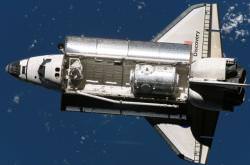NASA astronauts added the newest module to the International Space Station on Friday morning, clearing the way for several new laboratory modules and increasing the sleeping capacity. Astronauts Scott E. Parazynski and Col. Douglas H. Wheelock spent their morning on Friday, suspended above the planet, attaching the newly delivered Harmony module to the station. During the second spacewalk on Sunday, the astronauts discovered damage to one of the joints that orient the station’s solar arrays.
First Spacewalk – Friday
Once the shuttle docked on Thursday, the first scheduled spacewalk began early the next day. Parazynski and Wheelock went outside the station at 6 a.m. EDT, and prepared Harmony for its removal from the shuttle’s payload bay.
Inside the station, Stephanie D. Wilson and Daniel M. Tani operated the station’s robotic arm, to help remove the module from the shuttle’s cargo bay and transfer it over to the station.
The spacewalk itself went quickly, and mostly without incident. The astronauts struggled briefly to remove some of holding bolts and hose connectors. And there were a few situations where frozen ammonia drifted away from some of the hoses. This ammonia could contaminate the station’s atmosphere if it got back inside, so the astronauts carefully avoided coming into contact with any of the substance.
Second Spacewalk – Sunday
For the second spacewalk on Sunday, Scott Parazynski was joined by Daniel M. Tani. Their task was to unbuckle a solar array atop the station so that it can be relocated. They also began outfitting the exterior of the newly attached Harmony module.
After removing a protective cover, Tani discovered what appeared to be metallic shavings in one of the station’s rotating joint assemblies. He collected up some samples with tape so that engineers can study it, and figure out what could be going on. Station controllers had noticed that a joint on the right-hand side of the station was experiencing unusual vibrations as it rotated, so these two events could be connected.
The best theory right now is that the foil backing on an aluminum cover is rubbing against the mechanism that turns the station’s solar arrays to orient towards the Sun. This material is shredding off the cover and getting into the mechanism.
NASA is considering whether they’ll have the astronauts open up all 21 covers to see if any are the source of the damage. This could be done during a currently planned spacewalk, or it could become another spacewalk all on its own. Even if the source of the metal is discovered, it might be impossible to clean.
Original Source: NASA Station Coverage

